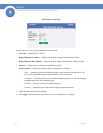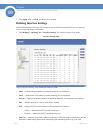
159
Chapter 10:
SFE2000/SFE2000P Gigabit Ethernet Switch Reference Guide
Chapter
10
• BPDU Handling — Determines how BPDU packets are managed when STP is disabled on the port/
device. BPDUs are used to transmit spanning tree information. The possible field values are:
– Filtering — Filters BPDU packets when spanning tree is disabled on an interface. This is the
default value.
– Flooding — Floods BPDU packets when spanning tree is disabled on an interface.
• Path Cost Default Values — Specifies the method used to assign default path costs to STP ports.
The possible field values are:
– Short — Specifies 1 through 65,535 range for port path costs. This is the default value.
– Long — Specifies 1 through 200,000,000 range for port path costs.The default path costs
assigned to an interface varies according to the selected method.
The Bridge Settings area contains the following fields:
• Priority — Specifies the bridge priority value. When switches or bridges are running STP, each is
assigned a priority. After exchanging BPDUs, the device with the lowest priority value becomes the
Root Bridge. The default value is 32768. The port priority value is provided in increments of 4096.
For example, 4096, 8192, 12288, etc. The range is 0 to 65535.
• Hello Time — Specifies the device Hello Time. The Hello Time indicates the amount of time in
seconds a root bridge waits between configuration messages. The default is 2 seconds. The range is 1
to 10 seconds.
• Max Age — Specifies the device Maximum Age Time. The Maximum Age Time indicates the
amount of time in seconds a bridge waits before sending configuration messages. The default max
age is 20 seconds. The range is 6 to 40 seconds.
• Forward Delay — Specifies the device forward delay time. The Forward Delay Time indicates the
amount of time in seconds a bridge remains in a listening and learning state before forwarding
packets. The default is 15 seconds. The range is 4 to 30 seconds.
The Designated Root area contains the following fields:
• Bridge ID — Identifies the Bridge ID and MAC address.
• Root Bridge ID— Identifies the Root Bridge priority and MAC address.
• Root Port — Indicates the port number that offers the lowest cost path from this bridge to the Root
Bridge. It is significant when the Bridge is not the Root. The default is zero.
• Root Path Cost — The cost of the path from this bridge to the root.
• Topology Changes Counts — Indicates the total amount of STP state changes that have occurred.
• Last Topology Change — Indicates the amount of time that has elapsed since the bridge was
initialized or reset, and the last topographic change occurred. The time is displayed in a day hour
minute second format, for example, 2 days 5 hours 10 minutes and 4 seconds:
2. Define the relevant fields.


















